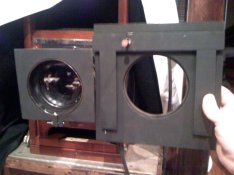My earlier post was a bit flip, but in all seriousness, the weight of a ULF field becomes a consideration, and that points to the crux of a design- functional, without being clunky, unbearably heavy, or crude. In addition to Scotts list, you would most likely need a metal milling machine, and a bender, to make the small parts, as most are not easily or inexpensivly sourced, and small runs by a machinist are spendy.
Of course those costs can be built in to the price of the camera, but then you are playing the market, if you are talking about commercial production. If you are just building a one off for your self, and I certainly understand that desire, you will lose the economy of scale (such that there is in LF gear) and you will spend as much or more fabricating and designing, than buying a name brand one, so the motivating factor would have to be the desire to do it for ones own edification.
I have built a couple super simple cameras, and as a result wouldn't touch building a holder with a ten foot pole, but you may have more skill and confidence than I.
If I was going to build a ULF camera, I would probably start with a monorail design, then a flat bed with a tail board, before I tackled a folding field, as far as the learning curve. On the other hand you could just beat your head on the latter and be done with it.












